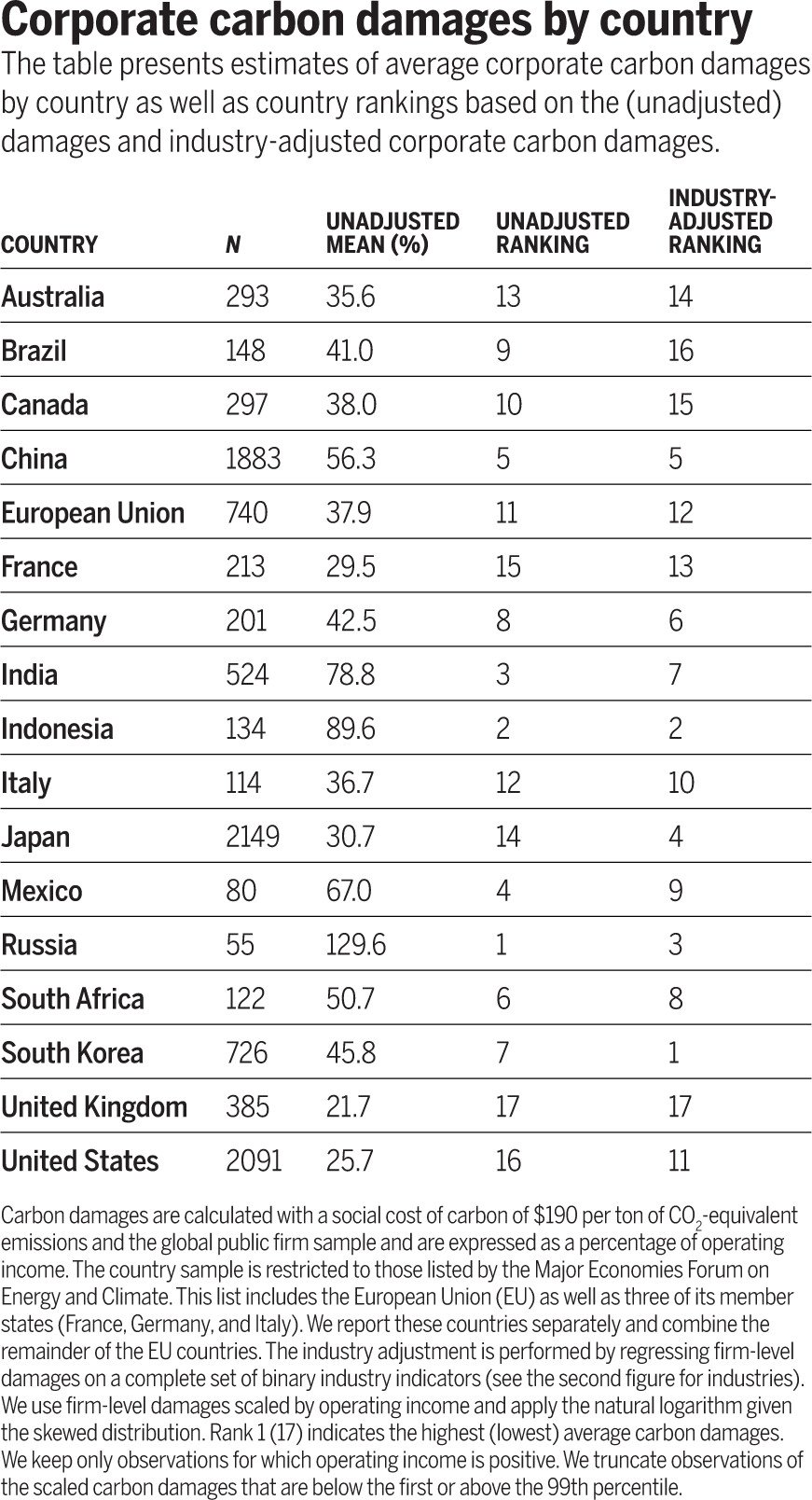

In March 2022, the Securities and Exchange Commission proposed a rule requiring companies to provide climate-related information in registration statements and annual reports. Specifically, the SEC wants companies to reveal climate-related risks and financial metrics.
In theory, a standardized reporting requirement would replace the current abundance of metrics related to the “E” part of ESG investing. Economists Michael Greenstone and Christian Luez of the University of Chicago and Patricia Breuer of the University of Mannheim published a study on Thursday in Science magazine that offers a “first-cut” at a standardized way to evaluate companies’ greenhouse gas emissions.
As with the SEC’s proposed rule, the study’s goal is to “provide information on material risks to investors, making it evident which firms are most exposed to future climate policies.” The authors introduce the idea of “corporate carbon damages” as a “measure of the total costs to society associated with corporate emissions.” (These 20 banks are still pouring billions into the fossil fuel industry.)
Corporate carbon damages are calculated as the product of carbon dioxide-equivalent direct emissions and the social cost of carbon; that is, the monetary value of the damages associated with the release of an additional metric ton of CO2. That number is then divided by a company’s operating profit or sales to account for the differences in size among companies. The authors used a data set of about 15,000 global public companies for their study.
In a nutshell: “The core finding is that average corporate carbon damages are large, but they vary greatly across firms within an industry, across industries, and across countries.” From that base, the authors argue for mandatory disclosure of a company’s corporate carbon damage because a reliable measure of GHG emissions is the basis from which climate policy must begin.
The study focuses on what are known as Scope 1 emissions. These are the direct emissions from activities and facilities owned or controlled by a company. The more inclusive Scope 2 limits include indirect emissions from purchased electricity and the even more inclusive
Scope 3 includes upstream production inputs (e.g., the equipment the company acquires and uses to make its products) and downstream use (e.g., the gasoline that people use in their personal vehicles). While Scope 1 has its limitations, it avoids the major issue of double-counting carbon damage for an individual firm.
The study uses the U.S. EPA’s social cost of carbon figure of $190 per metric ton of CO2-equivalent emissions as its baseline but has also calculated the carbon damage based on an Obama-era cost of $51 and on a $250 cost reflecting costs not included in the EPA’s baseline.
According to the live carbon price monitor at CarbonCredits.com, Friday morning, carbon prices in markets that require compliance vary from a high of €86.90 ($93.86) in the European Union to a low of $8.23 in China. In the voluntary offset markets, carbon credits trade for less than $2 apiece. Even the EU is well short of the study’s $190 baseline carbon price.
Only 31% of the data used to complete the study was supplied directly by the companies. The rest was estimated by S&P Global Trucost using a model that relies on voluntary emissions reports from a variety of sources.
Based on their data set, the authors calculate that global corporate carbon damages average about 44% of a firm’s operating profit and 3.1% of revenue. U.S. firms’ average damages total 18.5% of operating profit and 2% of revenue. On a weighted scale that accounts for a firm’s size, average damages total 34.2% globally and 15.6% in the United States.
Mean damage “far exceeds” median damages due to skewing from both very large and very small companies at either end of the scale. The study indicates that at the 10th percentile of carbon damages, the hit to profit is just 0.1%, while at the 90th percentile, it is 85.8%. In the United States, for example, the energy sector’s carbon damages are 233.7% of profits at the 90th percentile firm (e.g., Exxon Mobil or Chevron) and just 4.5% at a 10th percentile firm. Globally, the 90th percentile’s damages are 382.9% of profits.
The authors stress in their conclusion that the results of the study are based on voluntary reporting and estimates: “This is not a small caveat and underscores the need for mandatory and verified emissions reporting.” Mandatory carbon damage reports would “aid in decreasing GHG emissions” and “help financial markets to discipline GHG emissions by pricing existing and expected future environmental policies.” Another benefit is that mandated disclosure “can incentivize firms to reign in environmental externalities, such as GHG emissions, even in the absence of environmental policy.”
Here’s a table from the study showing estimated corporate carbon damage by country.
Smart Investors Are Quietly Loading Up on These “Dividend Legends” (Sponsored)
If you want your portfolio to pay you cash like clockwork, it’s time to stop blindly following conventional wisdom like relying on Dividend Aristocrats. There’s a better option, and we want to show you. We’re offering a brand-new report on 2 stocks we believe offer the rare combination of a high dividend yield and significant stock appreciation upside. If you’re tired of feeling one step behind in this market, this free report is a must-read for you.
Click here to download your FREE copy of “2 Dividend Legends to Hold Forever” and start improving your portfolio today.
Thank you for reading! Have some feedback for us?
Contact the 24/7 Wall St. editorial team.




